After our eventful morning in Sielen with Julia and Hans-Peter, we all headed to Trendelburg. At one time the cemetery there had been used by the Jewish residents of Sielen, so I hoped that perhaps I’d find a Schoenthal ancestor buried there. But that one had even fewer stones as it had been desecrated by the Nazis. There were no Schoenthals there.
But Trendelburg itself was an interesting place to visit. It was here that my great-great-uncle Henry Schoenthal had taught in the Jewish school after attending the seminary in Kassel.
First, Julia showed us another old mikveh that had been discovered in a basement like the one Ernst Klein had found in Volksmarsen. This one was discovered in 2001 when an abandoned house was undergoing renovation. The mikveh is believed to have been closed sometime in the 19th century and perhaps replaced with another. There had been a fire in the building at some point, but the basement and the mikveh had survived.
Julia explained that it was believed that the mikveh dated to the late 18th century because there are documents dated 1782-1783 in which a man named Joseph Levi asked for permission to build a pipe to his cellar from the town well. Although a mikveh is supposed to be fed by natural water—spring, groundwater, or rain—in this case it appeared that a conduit was necessary to supply the water for the ritual bath.
The other interesting landmark in Trendelburg is the castle believed to be the inspiration for the story of Rapunzel by the Brothers Grimm. I wrote more about the castle’s history here.
Now the castle is used as a hotel and a restaurant, and Julia, Hans-Peter, Harvey, and I went into the restaurant for coffee, and then after Hans-Peter left to teach a seminar in Kassel, Julia, Harvey, and I had lunch there. It was lovely, and it gave us a chance to talk to Julia about her life (she is an artist) and her reasons for volunteering her time to preserve the Jewish history of these towns. Like the others, she also felt compelled to learn what had happened and to educate others about German Jewish history and the Holocaust.
While at lunch, Julia also presented me with wedding documents for a Rosa Hamberg from Breuna who married a man named Benjamin Cohn. I did not know who she was or how she fit into my family tree, but after further help and research, Julia, Hans-Peter, and I figured it out. More on that in a later post.
After lunch, we went with Julia to the town where she lives, Hofgeismar, to see the museum she and her colleagues have created in that town to educate others about its Jewish history. We were really impressed by the museum. Not only are there wonderful materials to teach about Judaism and the Holocaust, Julia and her colleagues have developed an extremely creative curriculum for high school students that has them engage in interactive ways to learn about the Jewish history of their region. For example, the students created a replica of the ark that once existed in the synagogue by using data about its measurements from old documents. They also created a mural that depicts in detail what the Hofgeismar synagogue had looked like—again, using old plans and documents to be as accurate as possible.
It was a curriculum so creative and thoughtful that we both felt that it was something that educators in the US could use effectively to teach students about Jewish history. This is another project that deserves the support of anyone who is interested in preventing the ignorance and hatred that led to the Holocaust. You can learn more at their website here.
After saying a grateful and emotional goodbye to Julia, we headed back to Kassel. But our day was not over. After a short break back in Kassel, Hans-Peter picked us up at 5;30 for a trip to Gudensberg. I am not sure how Hans-Peter had the energy. We were already exhausted and had had a break; he’d been in Sielen and Trendelburg with us and then had taught a class in Kassel and was now ready to drive us back out to Gudensberg, which is 25 kilometers south and another half hour drive away.
And I wasn’t even sure why we were going to Gudensberg. As far as I knew, the only family connection I had to that village was through my great-grandfather’s brothers, Henry and Jakob Schoenthal, who had married Charlotte and Helen Lilienfeld, two sisters from Gudensberg.
So we piled into Hans-Peter’s car off for another adventure. First we went to the cemetery in Obervorschuetz, just a few miles from Gudensberg. This is a huge cemetery—with close to 400 stones dating as far back as 1727. Hans-Peter had collected information about possible relatives of mine who were buried in this cemetery; he had photocopied the photographs of the relevant stones from the LAGIS website of Jewish gravestones. They were all members of the Mansbach family from Maden: Liebmann (1813-1874), Schoene (d. 1879), Chaja Mansbach (geb. Speier)(1787-1861), and Hannchen Mansbach (geb. Katzenstein) (1799-1840). As I looked at the names, only the last was familiar.
But when I got home, I researched a few of the others and realized that Liebmann Mansbach was the father of Rose Mansbach, who married Simon Schoenthal, my great-grandfather’s brother. Schoene Mansbach was Liebmann’s daughter and Rose’s sister. Chaja Speier Mansbach was Liebmann’s mother, Rose’s grandmother. So they were all related to me, albeit only through marriage, but nevertheless all were in my family tree. Hans-Peter had noted the connections, but I guess my addled brain did not absorb it all at the time.
But Hannchen Mansbach geb. Katzenstein was in fact my blood relative. She was the half-sister of my great-great-grandfather Gerson Katzenstein and the daughter of Scholem Katzenstein, my three-times great-grandfather. As I wrote about here, she had married Marum Mansbach of Maden, with whom she’d had six children, including three who came to the US: Henrietta, Abraham, and H.H (Harry), about whom I’ve written extensively. Hannchen had died after giving birth to Harry in 1840. It was her stone I was most interested in seeing.
So we started on a treasure hunt, trying to find these stones. It was a real challenge—almost 400 stones, and all we had were small photographs of the stones to use to locate the actual stone and a map filled with hundreds of square that Hans-Peter had highlighted, but that was not that easy to follow.
I believe that this is the stone for Chaja Speier Mansbach:
But the others we could not find for sure. The stones were eroded, making it very difficult to read the Hebrew inscriptions and compare them to the sheets that Hans-Peter had printed. The sun was getting lower in the sky, creating a glare on the stones and making them even harder to read. And there were so many stones (and we had all had a long day already) that I was ready to give up.
And then I spotted this stone where the name was written in German on the reverse:
And this was on the Hebrew side:
It took some doing, but I was able to discern that this was in fact the stone for Hannchen Katzenstein Mansbach, whose sons had served on opposite sides of the US Civil War and who had both gone on to considerable success in America as had their sister Henrietta, who married Gabriel Gump. Hannchen was my three-times great-aunt. The Hebrew inscription on her stones is translated as:
A virtuous woman, she was like Abigail.
She noted that her trade was good. She was modest
In her speech. Her actions were pleasant. Of the king’s daughter
Would be her interior. She was a wise woman.
Her soul rose up into the sky. She changed her whole life
On straight paths. She kept the Lord’s commandments. Henchen,
Daughter of Shelom ha-Kohen, wife of Me’ir, son of
Elieser from Maden. She went into her world
And died on Saturday, the 2nd Tammuz, and was buried on Sunday [5] 600
After the small count. Her soul is bound up in the covenant of life
With all the other just women in the Garden of Eden,
Amen. Her soul was bound in covenant.
As you can see from the photographs, we left stones on her headstone, marking our visit and honoring not only her, but all her descendants. I was now very glad that we had gone to visit this cemetery.
But our day was not yet over. We next went to the town of Gudensberg, home of Charlotte and Helen Lilienfeld, sisters and the wives of Jakob and Henry Schoenthal, my great-great-uncles. Henry Schoenthal had married Helen in Gudensberg in 1872 after immigrating to the US. Jakob had married Charlotte in Gudensberg in 1879; they later settled in Cologne, as I wrote about here.
The principal thing that Hans-Peter wanted us to see in Gudensberg was the former synagogue. He and his wife had been very active in preserving and restoring the synagogue, and it was that project that inspired him to go on to do so much work in preserving the records of the former Jewish communities in the Nordhessen region. It is quite a beautiful restoration.
Today the building is used primarily as a cultural center and music school, although I understand that at times it has been used for Jewish religious celebrations.
We also saw the former Jewish school and the stolpersteine there for the man who was the last head of the school and his family.
And we saw the house of Michael Lilienfeld, brother of Charlotte and Helen, the sisters who married two of my Schoenthal great-great-uncles.
Hans-Peter then returned us to our hotel in Kassel. It had been a long and fascinating day, and my spirits were lifted after seeing all the incredible work that both Julia Drinnenberg and Hans-Peter Klein have done and are doing to preserve the history of the Jewish communities of the four towns we’d visited that day. It was a lot to process as we ate for a second night in the Italian restaurant across from our hotel.
The next morning we were heading to Jesberg, home of the Katzensteins.

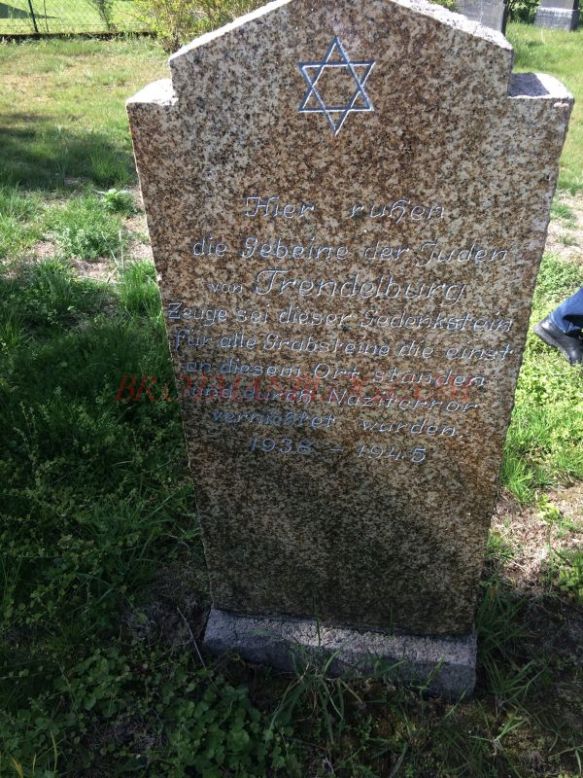
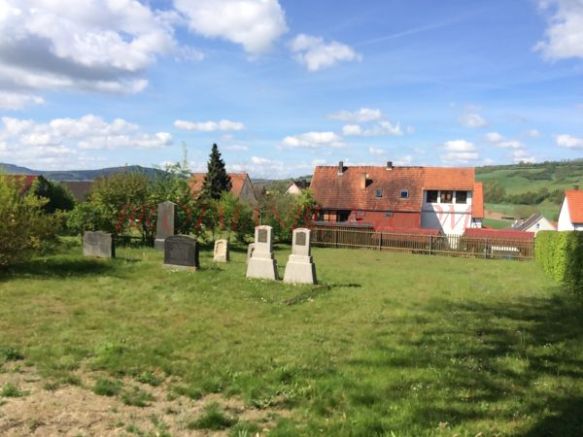





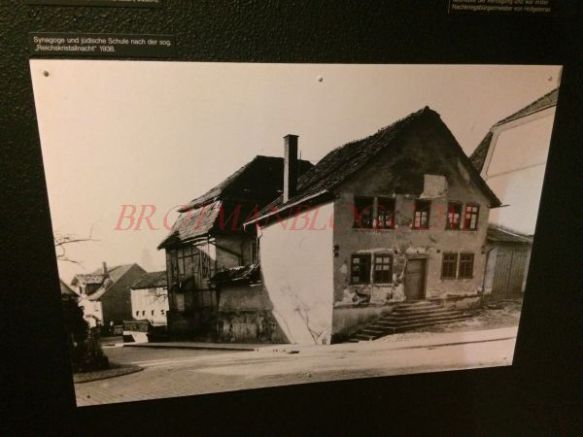
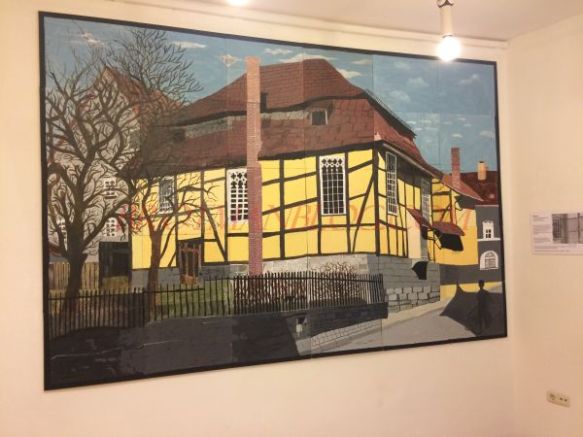










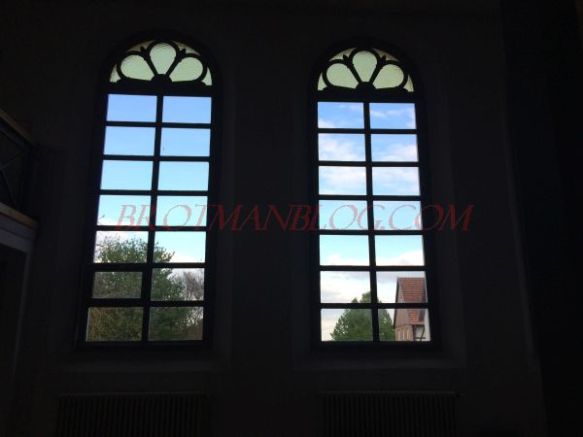




Amy, very moving your cemetery search in Gudens-BERG (mountain or hill – BURG = castle).
A number of years I became a member of the commission – http://kgj-hessen.de/home-en.html,
founded in 1963 – who, among other topics, works on the 75 oldest Jewish cemeteries in Hessen – now documented in LAGIS. It is so important that photos of gravestones were taken already in the 1960’s when many of them were in better shape.
Btw, the small reform congregation was in Gudensberg from 2001 to June 2010; since then in Felsberg: http://www.emetweschalom.de/en/our-congregation.html.
Eager to read about your next stop!!
LikeLiked by 1 person
Damn German place names always confound me!! OK, I will go edit that mistake. Sigh… Thank you!
Yes, we all have to be grateful that someone years ago had the wisdom to photograph and document the stones before further erosion. Looking at the photographs on LAGIS really was essential because as you can see from the photos, they are almost illegible now.
I am so grateful to all those like you who have done so much good work!!
LikeLike
Seeing the restored synagogue gladdened my heart, even though it is not used for religious services.
LikeLiked by 1 person
Yes, me too. Someone in one of the Facebook groups told me that it has occasionally been used for religious purposes–her son had his bar mitzvah there. But not very often.
LikeLiked by 1 person
Amy, I think you make a very cool and modern Rapunzel. It’s the shades that do it!
LikeLiked by 1 person
LOL! I always wondered what I’d look like with long blonde hair… 🙂
LikeLiked by 1 person
Dear Amy, thank you for your wonderful report. It called back to me our meeting that I enjoyed very much. I think, you needed a long time to recover from such a tiring chedule. As for your questions above: You are right, the Superindendent Braun was an Antisemit who adopted the common prejudices about “The Jew” in general – on the other side he thought about the lokal Jews in a different way. Crazy, isn’t it! Best wishes and regards from Julia.
LikeLiked by 1 person
I am so glad you enjoyed it, my friend. And thank you for the clarification about Superintendent Braun (not to be confused with the nice man we met in Sielen!). Can you tell me how you found that document? It was very interesting!
LikeLike
This was an amazing post filled with so much information and fabulous pictures. I loved reading about the Mansbachs in your past posts and well Hannchen Katzenstein is like a household name to me 🙂 lol loved the post Amy.
LikeLiked by 1 person
Thanks, Sharon! You can imagine how I felt on finding her gravestone after learning so much about her children!
LikeLiked by 1 person
I can only imagine….I know how I feel just getting a photograph in the mail from a cemetery. Imagining seeing a stone in person is beyond a dream come true…living through your amazing posts. Excited for the next one!
LikeLiked by 1 person
Thanks so much, Sharon!
LikeLike
What an extraordinary day (within a pretty amazing trip). Wonderful finds, but even better perhaps to meet and share friendship with such lovely people as Julia and Hans-Peter and to know that the work of remembering is on-going.
LikeLiked by 1 person
Thanks, Su! It really was extraordinary AND exhausting!!
LikeLiked by 1 person
It sounded exhausting. Hope the next day was more restful.
LikeLiked by 1 person
Ha! Maybe a bit—but still not much down time!
LikeLiked by 1 person
That’s the thing with holidays. You need a holiday to recover from them.
LikeLiked by 1 person
LOL! Very true!
LikeLiked by 1 person
You certainly experienced another extraordinary day. This is so inspiring, not just to read as another blogger, or even one with genealogical interests, but for the preservation of Jewish history. This is fabulous and I am quite inspired to make a trip to Germany. I am curious whether you organized your days ahead of time with specified guides or did you ‘wing it’? I can see advantages to both.
LikeLiked by 1 person
Oh, I made every guide arrangement WAY ahead of time—months and months. All but two of the guides were volunteers so I wanted to be sure they were available and I planned the days around their availability. Even the group tour in Cologne I reserved ahead of time. I like those things nailed down as well as hotels and cars. But restaurants we are happy to go with the flow!
LikeLike
Loved your Rapunzel smile. It was wonderful to read you discovered a stone with a true connection. What a day!
LikeLiked by 1 person
Ah, but no long blonde hair.. 🙂
LikeLiked by 1 person
I know, you’re just not a blond person. I can’t think of myself as anything but a redhead.
LikeLiked by 1 person
So fascinating that the mikveh was found – and it looks to be in relatively good shape after all these years. And you are a champ at looking for stones – not just erosion was a challenge but having them in Hebrew, as well.
LikeLiked by 1 person
Hebrew and German…not easy! But I am glad for the Hebrew because it reveals the father’s name. If you can read it…
LikeLike
What a cool day Amy! I am so impressed by the curriculum Julia has created. It is difficult to create a curriculum like that with engaging activities, especially on such a critically important topic. I hope it continues to flourish.
LikeLiked by 1 person
So do I, Amberly. I just wish I could bring it to the US for teenagers here.
LikeLiked by 1 person